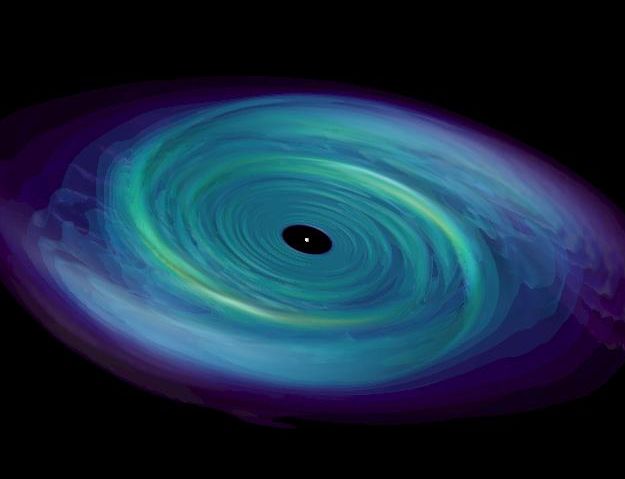Credit & Copyright: Michael Owen,
John Blondin
(North Carolina State Univ.)
Explanation:
Don't be fooled by the familiar symmetry.
The graceful spiral structure seen
in this computer visualization does not portray winding spiral arms in
a distant galaxy of stars.
Instead, the graphic shows spiral shock waves in a three dimensional
simulation of an
accretion disk -- material
swirling
onto a compact
central object that could represent a
white dwarf star,
neutron star,
or black hole.
Such accretion disks power bright
x-ray sources
within our own galaxy.
They form in binary star systems which consist of a donor star (not
shown above), supplying the accreting material, and a compact object
whose strong
gravity ultimately draws the material towards its surface.
For known
x-ray
binary systems the size of the accretion disk
itself might fall somewhere between the diameter of the Sun
(about 1,400,000 kilometers) and the diameter of the
Moon's orbit (800,000 kilometers).
One interesting result of the
virtual
reality astrophysics
illustrated here is that the simulated
disk develops instabilities
which tend to smear out the pronounced spiral shocks.
1999 2000 2001 2002 2003 2004 2005 2006 2007 2008 2009 2010 2011 2012 2013 2014 2015 2016 2017 2018 2019 2020 2021 2022 2023 2024 2025 |
Yanvar' Fevral' Mart Aprel' Mai Iyun' Iyul' Avgust Sentyabr' Oktyabr' Noyabr' Dekabr' |
NASA Web Site Statements, Warnings, and Disclaimers
NASA Official: Jay Norris. Specific rights apply.
A service of: LHEA at NASA / GSFC
& Michigan Tech. U.
|
Publikacii s klyuchevymi slovami:
accretion disk - binary star - neutron star - black hole - akkrecionnyi disk - dvoinaya sistema - rentgenovskoe izluchenie - neitronnye zvezdy - chernye dyry
Publikacii so slovami: accretion disk - binary star - neutron star - black hole - akkrecionnyi disk - dvoinaya sistema - rentgenovskoe izluchenie - neitronnye zvezdy - chernye dyry | |
Sm. takzhe:
Vse publikacii na tu zhe temu >> | |
